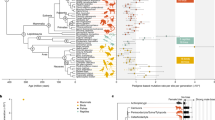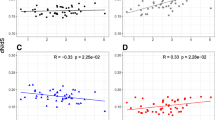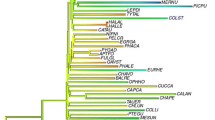Abstract
Germline mutation rates have been found to be higher in males than in females in many organisms, a likely consequence of cell division being more frequent in spermatogenesis than in oogenesis. If the majority of mutations are due to DNA replication error, the male-to-female mutation rate ratio (αm) is expected to be similar to the ratio of the number of germ line cell divisions in males and females (c), an assumption that can be tested with proper estimates of αm and c. αm is usually estimated by comparing substitution rates in putatively neutral sequences on the sex chromosomes. However, substantial regional variation in substitution rates across chromosomes may bias estimates of αm based on the substitution rates of short sequences. To investigate regional substitution rate variation, we estimated sequence divergence in 16 gametologous introns located on the Z and W chromosomes of five bird species of the order Galliformes. Intron ends and potentially conserved blocks were excluded to reduce the effect of using sequences subject to negative selection. We found significant substitution rate variation within Z chromosome (G15 = 37.6, p = 0.0010) as well as within W chromosome introns (G15 = 44.0, p = 0.0001). This heterogeneity also affected the estimates of αm, which varied significantly, from 1.53 to 3.51, among the introns (ANOVA: F13,14 =2.68, p = 0.04). Our results suggest the importance of using extensive data sets from several genomic regions to avoid the effects of regional mutation rate variation and to ensure accurate estimates of αm.

Similar content being viewed by others
References
Abajian (1994) Sputnik. Available at: http://www.abaijan.net/sputnik/index.html
Agulnik AI, Bishop CE, Lerner JL, Agulnik SI, Solovyev VV. (1997) Analysis of mutation rates in the SMCY/SMCX genes shows that mammalian evolution is male driven. Mammal Genome 8:134–138
Axelsson E, Smith NG, Sundstrom H, Berlin S, Ellegren H (2004) Male-biased mutation rate and divergence in autosomal, Z-linked and W-linked introns of chicken and turkey. Mol Biol Evol 21:1538–1547
Barnes WM (1992) The fidelity of Taq polymerase catalyzing PCR is improved by an N-terminal deletion. Gene 112:29–35
Bartosch-Härlid A, Berlin S, Smith NG, Møller AP, Ellegren H (2003) Life history and the male mutation bias. Evolution 57:2398–2406
Berlin S, Ellegren H (2004) Chicken W: a genetically uniform chromosome in a highly variable genome. Proc Natl Acad Sci USA 101:15967–15969
Bohossian HB, Skaletsky H, Page DC (2000) Unexpectedly similar rates of nucleotide substitution found in male and female hominids. Nature 406:622–625
Carmichael AN, Fridolfsson AK, Halverson J, Ellegren H (2000) Male-biased mutation rates revealed from Z and W chromosome-linked ATP synthase alpha-subunit (ATP5A1) sequences in birds. J Mol Evol 50:443–447
Chamary JV, Hurst LD (2004) Similar rates but different modes of sequence evolution in introns and at exonic silent sites in rodents: evidence for selectively driven codon usage. Mol Biol Evol 21:1014–1023
Chang BH, Li WH (1995) Estimating the intensity of male-driven evolution in rodents by using X-linked and Y-linked Ube 1 genes and pseudogenes. J Mol Evol 40:70–77
Chang BH, Shimmin LC, Shyue SK, Hewett-Emmett D, Li WH (1994) Weak male-driven molecular evolution in rodents. Proc Natl Acad Sci USA 91:827–831
Chicken Genome Consortium (2004) Sequence and comparative analysis of the chicken genome provide unique perspectives on vertebrate evolution. Nature 432:695–716
Crow JF (1997) The high spontaneous mutation rate: is it a health risk? Proc Natl Acad Sci USA 94:8380–8386
Dimcheff DE, Drovetski SV, Mindell DP (2002) Phylogeny of Tetraoninae and other galliform birds using mitochondrial 12S and ND2 genes. Mol Phylogenet Evol 24:203–215
Ebersberger I, Metzler D, Schwarz C, Paabo S (2002) Genomewide Comparison of DNA Sequences between Humans and Chimpanzees. Am J Hum Genet 70:1490–1497
Ellegren H, Fridolfsson AK (1997) Male-driven evolution of DNA sequences in birds. Nat Genet 17:182–184
Ellegren H, Fridolfsson AK (2003) Sex–specific mutation rates in salmonid fish. J Mol Evol 56:458–463
Ellegren H, Smith NGC, Webster MT (2003) Mutation rate variation in the mammalian genome. Curr Opin Genet Dev 13:562–568
Filatov DA, Charlesworth D (2002) Substitution rates in the X- and Y-linked genes of the plants, Silene latifolia and S. dioica. Mol Biol Evol 19:898–907
Filatov DA (2005) Substitution rates in a new Silene latifolia sex-linked gene, SlssX/Y. 22:402–408
Fridolfsson AK, Ellegren H (2000) Molecular evolution of the avian CHD1 genes on the Z and W sex chromosomes. Genetics 155:1903–1912
Girard M, Couvert P, Carrie A, Tardieu M, Chelly J, Beldjord C, Bienvenu T (2001) Parental origin of de novo MECP2 mutations in Rett syndrome. Eur J Hum Genet 9:231–236
Haldane JBS (1935) The rate of spontaneous mutation of a human gene. J Genet 31:317–326
Handley LJ, Ceplitis H, Ellegren H (2004) Evolutionary strata on the chicken Z chromosome: implications for sex chromosome evolution. Genetics 167:367–76
Hardison RC, Roskin KM, Yang S, Diekhans M, Kent WJ, Weber R, Elnitski L, Li J, O’Connor M, Kolbe D, Schwartz S, Furey TS, Whelan S, Goldman N, Smit A, Miller W, Chiaromonte F, Haussler D (2003) Covariation in frequencies of substitution, deletion, transposition, and recombination during eutherian evolution. Genome Res 13:13–26
Hare MP, Palumbi SR (2003) High intron sequence conservation across three mammalian orders suggests functional constraints. Mol Biol Evol 20:969–978
Ibarguchi G, Gissing GJ, Gaston AJ, Boag PT, Friesen VL (2004) Male-biased mutation rates and the overestimation of extrapair paternity: problem, solution, and illustration using thick-billed murres (Uria lomvia, Alcidae). J Hered 95:209–216
Kahn NW, Quinn TW (1999) Male-driven evolution among Eoaves? A test of the replicative division hypothesis in a heterogametic female (ZW) system. J Mol Evol 49:750–759
Kirkpatrick M, Hall DW (2004) Male-biased mutation, sex linkage, and the rate of adaptive evolution. Evol Int J Org Evol 58:437–440
Kumar S, Tamura K, Jakobsen IB, Nei M (2001) MEGA2: molecular evolutionary genetics analysis software. Bioinformatics 17:1244–1245
Lercher MJ, Williams EJ, Hurst LD (2001) Local similarity in evolutionary rates extends over whole chromosomes in human-rodent and mouse-rat comparisons: implications for understanding the mechanistic basis of the male mutation bias. Mol Biol Evol 18:2032–2039
Li WH, Yi S, Makova K (2002) Male-driven evolution. Curr Opin Genet Dev 12:650–656
Lu J, Wu CI (2005) Weak selection revealed by the whole–genome comparison of the X chromosome and autosomes of human and chimpanzee. Proc Natl Acad Sci USA 102:4063–4067
Ludwig MZ (2002) Functional evolution of noncoding DNA. Curr Opin Genet Dev 12:634–639
Lundberg KS, Shoemaker DD, Adams MW, Short JM, Sorge JA, Mathur EJ (1991) High–fidelity amplification using a thermostable DNA polymerase isolated from Pyrococcus furiosus. Gene 108:1–6
Malcom CM, Wyckoff GJ, Lahn BT (2003) Genic mutation rates in mammals: local similarity, chromosomal heterogeneity, and X-versus-autosome disparity. Mol Biol Evol 20:1633–1641
Makova KD, Li WH (2002) Strong male-driven evolution of DNA sequences in humans and apes. Nature 416:624–626
Makova KD, Yang S, Chiaromonte F (2004) Insertions and deletions are male biased too: a whole-genome analysis in rodents. Genome Res 14:567–573
McVean GT, Hurst LD (1997) Evidence for a selectively favourable reduction in the mutation rate of the X chromosome. Nature 386:388–392
Miyata T, Hayashida H, Kuma K, Mitsuyasu K, Yasunaga T (1987) Male-driven molecular evolution: a model and nucleotide sequence analysis. Cold Spring Harbor Symp Quant Biol 52:863–867
Nachman MW (2002) Variation in recombination rate across the genome: evidence and implications. Curr Opin Genet Dev 12:657–663
Sachidanandam R, Weissman D, Schmidt SC et al. (2001) A map of human genome sequence variation containing 1.42 million single nucleotide polymorphisms. Nature 409:928–933
Schwartz S, Zhang Z, Frazer KA, Smit A, Riemer C, Bouck J, Gibbs R, Hardison R, Miller W (2000) PipMaker––a web server for aligning two genomic DNA sequences. Genome Res 10:577–586
Shimmin LC, Chang BH, Li WH (1993a) Male-driven evolution of DNA sequences. Nature 362:745–747
Shimmin LC, Chang BH, Hewett-Emmett D, Li WH (1993b) Potential problems in estimating the male-to-female mutation rate ratio from DNA sequence data. J Mol Evol 37:160–166
Smith NGC, Eyre-Walker A (2003) Partitioning the variation in mammalian substitution rates. Mol Biol Evol 20:10–17
Smith NGC, Webster MT, Ellegren H (2002) Deterministic mutation rate variation in the human genome. Genome Res 12:1350–1356
Sokal RR, Rohlf FJ (2000) Biometry—the principles and practice of statistics ion biological research. W.H. Freeman, New York
Tamura K, Nei M (1993) Estimation of the number of nucleotide substitutions in the control region of mitochondrial DNA in humans and chimpanzees. Mol Biol Evol 10:512–526
Thompson JD, Higgins DG, Gibson TJ (1994) CLUSTAL W: improving the sensitivity of progressive multiple sequence alignment through sequence weighting, position–specific gap penalties and weight matrix choice. Nucleic Acids Res 22:4673–4680
Trappe R, Laccone F, Cobilanschi J, Meins M, Huppke P, Hanefeld F, Engel W (2001) MECP2 mutations in sporadic cases of Rett syndrome are almost exclusively of paternal origin. Am J Hum Genet 68:1093–1101
Waterston RH, Lindblad-Toh K, Birney E, et al. (2002) Initial sequencing and comparative analysis of the mouse genome. Nature 420:520–562
Whittle CA, Johnston MO (2002) Male-driven evolution of mitochondrial and chloroplastidial DNA sequences in plants. Mol Biol Evol 19:938–949
Wilkin DJ, Szabo JK, Cameron R, Henderson S, Bellus GA, Mack ML, Kaitila I, Loughlin J, Munnich A, Sykes B, Bonaventure J, Francomano CA (1998) Mutations in fibroblast growth-factor receptor 3 in sporadic cases of achondroplasia occur exclusively on the paternally derived chromosome. Am J Hum Genet 63:711–716
Yang Z (1997) PAML: a program package for phylogenetic analysis by maximum likelihood. Comput Appl Biosci 13:555–556
Acknowledgments
Financial support was obtained from the Swedish Research Council to H.E and to S.B. H.E. is a Royal Academy of Sciences Research Fellow supported by a grant from the Knut and Alice Wallenberg Foundation. Cecilia Berg, Jacob Höglund, Anna Mattsson, and Ettore Randi are acknowledged for help with DNA samples.
Author information
Authors and Affiliations
Corresponding author
Additional information
[Reviewing Editor: Mr. Martin Kreitman]
Nick G.C. Smith Deceased
Electronic Supplementary Material
Rights and permissions
About this article
Cite this article
Berlin, S., Brandström, M., Backström, N. et al. Substitution Rate Heterogeneity and the Male Mutation Bias. J Mol Evol 62, 226–233 (2006). https://doi.org/10.1007/s00239-005-0103-6
Received:
Accepted:
Published:
Issue Date:
DOI: https://doi.org/10.1007/s00239-005-0103-6




